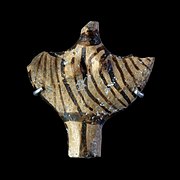Psi and phi type figurine

Tau-, Psi- and phi- type Greek terracotta figurines date back to 1450–1100 BC in Mycenaean Greece. They were typically small (about 10cm high), made of terracotta, although a group of ivory figurines has been found,[1] and were found in tombs, shrines and settlement areas. They are classified by their shape and a resemblance to the Greek letters of tau (τ), psi (ψ) and phi (Φ), according to a typological system created by Arne Furumark in 1941.[2]
Their function/purpose is unknown, although it has been suggested that their purpose changed with the context in which they were found. Possible uses were children's toys,[1] votive figurines or grave offerings.
Some figurines appear to wear flattened headdresses, which suggests they may be goddesses.[3] However, it is difficult to distinguish between goddesses and worshippers. It is likely that they were made by the same craftsmen who made Mycenaean vases, as the decoration techniques are similar.[3]
Examples of such figurines are held by the Goulandris Museum of Cycladic Art (Athens),[4] the British Museum (London),[5] and the Metropolitan Museum of Art (New York) among other places.[6]
- Psi-shaped figurine on display at the Musée d'Art et d'Histoire de Genève
- Phi-type and Psi-type Mycenaean female figurines; Museum of Cycladic Art, Athens. 14th–12th century BC
- Mycenaean figurines, "Bird goddesses", 14th–13th century BC
- Example of a Psi-shaped figurine of a woman. Mycenaean import found in Ugarit by Claude F. A. Schaeffer and Georges Chenet.
See also
[edit]References
[edit]- ^ a b Olsen, Barbara A (February 1998). "Women, Children and the Family in the Late Aegean Bronze Age: Differences in Minoan and Mycenaean Constructions of Gender". World Archaeology. 29 (3): 380–392. doi:10.1080/00438243.1998.9980386. JSTOR 125037.
- ^ French, Elizabeth (1971). "The Development of Mycenaean Terracotta Figurines". The Annual of the British School at Athens. 66: 101–187. doi:10.1017/S0068245400019146. JSTOR 30103231. S2CID 194064357.
- ^ a b British Museum. "Three terracotta figurines". Retrieved 17 July 2012.
- ^ "Female figurine (Psi type) | Museum of Cycladic Art". cycladic.gr. Retrieved 22 December 2018.
- ^ "figure". British Museum. Retrieved 22 December 2018.
- ^ "3 Terracotta female figures". www.metmuseum.org. Retrieved 22 December 2018.


 French
French Deutsch
Deutsch


